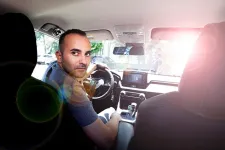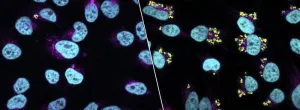(Press-News.org) URBANA, Ill. — Bioenergy crops such as miscanthus and switchgrass provide several environmental benefits, but low returns and profit risks are barriers for investment by farmers. A new study from the University of Illinois Urbana-Champaign shows that carbon mitigation payments could increase net returns and reduce income risk, potentially enticing more farmers to grow these crops.
“We were interested in looking at the returns to farmers and the risks to farm income of adopting bioenergy crops compared to conventional corn and soybean crops. We also wanted to look at the effects of paying farmers for the carbon mitigation services from these crops and how that would impact returns and risks,” said Madhu Khanna, Alvin H. Baum Family Chair and director of the Institute for Sustainability, Energy, and Environment (iSEE). She is also the ACES Distinguished Professor of Environmental Economics in the Department of Agricultural and Consumer Economics (ACE) and co-director of the Center for the Economics of Sustainability (CEOS), part of the College of Agricultural, Consumer and Environmental Sciences (ACES) at the U. of I.
“There are two main carbon mitigation benefits from bioenergy crops: First, bioenergy crops have deep roots that sequester more soil carbon than conventional crops. And second, the harvested biomass can be used to produce cellulosic biofuel to replace fossil fuels,” explained Fahd Majeed, a postdoctoral research associate at iSEE and the U.S. Department of Energy’s Center for Advanced Bioenergy and BioProducts Innovation (CABBI) at the U. of I. Majeed conducted the research as a doctoral student in CEOS.
Potential biomass profitability and return riskiness, along with the subsequent carbon mitigation potential of these crops, varies spatially due to weather-related yield risk and relative returns from conventional crops. Policies aimed at incentivizing farmers to convert cropland to bioenergy crops will need to address return riskiness along with high upfront costs and long establishment periods.
“Some farmers may be risk-averse and prefer lower but more stable profits, while others may be risk-neutral and prefer higher profits regardless of risk; however, this information may not be known to a policymaker,” Majeed noted. “Our analysis allows us to compare and rank risky returns from bioenergy crops and conventional crops when farmer risk preferences are unknown.”
The study, funded by the USDA National Institute of Food and Agriculture and CABBI, employed a biogeochemical model to simulate yields of bioenergy crops (miscanthus and switchgrass) and conventional crops (corn and soybean) under 30 years of randomized weather conditions. The researchers performed the analysis for 2,122 counties in the rainfed region of the United States, on or east of the 100th meridian. For conventional crops, they included corn-corn or corn-soybean rotation and till versus no-till practices.
They combined the yield analysis with an economic model estimating crop prices and carbon mitigation payments to gauge the appeal to different types of farmers across locations.
As both bioenergy and conventional crops vary in returns and riskiness across biomass and carbon prices, the researchers examined bioenergy crop profitability at biomass prices of $40 and $60 per metric ton and carbon payments of $0, $40, and $80 per metric ton of carbon dioxide (CO2). They found that bioenergy crops would not be profitable without carbon payments at lower prices. With carbon mitigation payments, these crops would appeal to risk-averse farmers; that is, farmers who are willing to accept slightly lower but less variable returns relative to conventional crops. At the higher biomass price of $60 per metric ton, carbon mitigation payments increase returns and reduce riskiness such that growing bioenergy crops would appeal to farmers regardless of risk preference.
Further, comparing the two bioenergy crops, the researchers found that miscanthus would be preferred over switchgrass by farmers in the Midwest, while switchgrass would be preferred over miscanthus by farmers in the southern states. This is due to spatial differences in the expected yield, carbon mitigation potential, and costs across bioenergy crops, the researchers said.
Overall, carbon mitigation payments can make bioenergy crops more appealing to farmers, but payments should be adapted to the varying potential yield, carbon mitigation, and riskiness of returns across regions.
“One policy implication from this study is that if you want to reduce risk, carbon credits are a good policy. But the incentives need to be tailored spatially; a uniform payment per acre of land across the whole region is not going to be the most effective. Carbon credits that vary across the region based on carbon mitigated will create differentiated incentives across the region compared to a uniform policy. The former will also be cost-effective in achieving an aggregate target for carbon mitigation,” Khanna said.
Currently, carbon mitigation payments are primarily facilitated through voluntary markets where companies and other organizations can purchase credits to meet their carbon reduction goals. Such markets can be supplemented with government programs to incentivize bioenergy crop production, the researchers noted.
Editor’s Notes:
The paper, “Carbon mitigation payments can reduce the riskiness of bioenergy crop production,” is published in the Journal of the Agricultural and Applied Economics Association [DOI: 10.1002/jaa2.52]. Authors include Fahd Majeed, Madhu Khanna, Ruiqing Miao, Elena Blanc-Betes, Tare Hudiburg, and Evan DeLucia.
Funding was provided by the National Institute of Food and Agriculture, Grant/Award Number: 2017‐67019‐26283; Hatch Project Number, Grant/Award Number: ALA011‐1‐ 17002; and the U.S. Department of Energy,Grant/Award Number: DE‐SC0018420
The College of Agricultural, Consumer and Environmental Sciences (ACES) at the University of Illinois has top-ranked programs, dedicated students, and world-renowned faculty and alumni who are developing solutions to the world’s most critical challenges to provide abundant food and energy, a healthy environment, and successful families and communities.
END
Carbon mitigation payments can make bioenergy crops more appealing for farmers
2023-06-15
ELSE PRESS RELEASES FROM THIS DATE:
Grant awarded to investigate antifungal therapies in Crohn’s patients
2023-06-15
Dr. Iliyan D. Iliev, an associate professor of immunology in medicine in the Division of Gastroenterology and Hepatology, co-director of the Microbiome Core and a member of the Jill Roberts Institute for Research in Inflammatory Bowel Disease (IBD) at Weill Cornell Medicine, is the lead investigator on a grant to Weill Cornell Medicine from The Leona M. and Harry B. Helmsley Charitable Trust to target pathogenic fungi in patients with Crohn’s disease.
Dr. Iliev teamed up with Dr. Randy Longman, ...
FAMU-FSU College of Engineering researchers want drivers to see clearly on the road
2023-06-15
Every year, sun glare contributes to around 3,000 crashes in the United States. FAMU-FSU College of Engineering researchers are helping to mitigate this problem by examining what drivers are likely to do when faced with sun glare. Their work was published in Transportation Research Record.
“We want drivers to be safer on the road,” said study co-author Eren Ozguven, director of the Resilient Infrastructure and Disaster Response Center. “At certain times of day, the sun can be blinding, so as scientists and engineers, we want to find solutions.”
The first step is to understand where problems are most likely to occur. ...
Scientists discover how Golden staph hides and thrives in human cells using state-of-the-art research tool
2023-06-15
Nearly one in three people globally unknowingly carries Golden staph, or Staphylococcus aureus, in their nose or on their skin. While the bacterium is harmless to most, it can lead to serious infection and even death if it enters the bloodstream through a cut, surgical wound or catheter.
The major breakthrough, led by the University of Melbourne’s Dr Abdou Hachani, a Senior Researcher at the Peter Doherty Institute for Infection and Immunity (Doherty Institute), published in the online medical journal eLife, was made possible by a new state-of-the-art ...
Massive underwater plateau near Solomon Islands is younger and its eruption was more protracted than previously thought, research suggests
2023-06-15
CORVALLIS, Ore. – The Ontong Java Plateau, a volcanically-formed underwater plateau located in the Pacific Ocean north of the Solomon Islands, is younger and its eruption was more protracted than previously thought, new research led by Oregon State University suggests.
The findings, just published in Science, also cast doubt on long-held assumptions that the formation of the plateau, which is roughly the size of Alaska, was the cause of a global deposit of black shale throughout the world’s oceans.
“This type of shale is formed when there is very limited oxygen in the ocean. This layer was formed about 120 million years ago and can be found preserved ...
Prenatal exposure to phthalates may impact future fertility differently in males and females, animal study finds
2023-06-15
Prenatal exposure to chemicals called phthalates, which are used in hundreds of products, may lead to hormonal changes in females that could affect their future fertility, suggests a study in mice being presented Thursday at ENDO 2023, the Endocrine Society’s annual meeting in Chicago, Ill.
The study found female mouse embryos exposed to phthalates during gestation had lower testosterone levels than those not exposed to the chemicals. Immediately after birth, female mice exposed to phthalates during gestation had lower levels of the hormone estradiol than those not exposed.
“These changes in hormone levels ...
Limiting opioids during surgery may lead to more postoperative pain and opioid use for patients
2023-06-15
BOSTON – Because of the opioid crisis, physicians are less likely to administer opioids to help manage patients’ pain, even in the operating room.
A recent analysis in JAMA Surgery that was conducted by investigators at Massachusetts General Hospital (MGH), a founding member of Mass General Brigham, indicates that overly restricting use of opioids during surgery may be doing more harm than good.
For the study, researchers analyzed information on 61,249 adults who had surgery at MGH from 2016–2020. Patients administered more of the ...
HaoSheng Sun named a Freeman Hrabowski scholar by the Howard Hughes Medical Institute
2023-06-15
BIRMINGHAM, Ala. – HaoSheng Sun, Ph.D., assistant professor in the University of Alabama at Birmingham Department of Cell, Developmental and Integrative Biology, has been named to the inaugural class of Freeman Hrabowski scholars by the Howard Hughes Medical Institute.
The 31 new scholars from 22 U.S. institutions are all outstanding early career faculty in science who have the potential to become leaders in their research fields, as well as advance diversity, equity and inclusion through their mentorship and understanding of the experiences of trainees from races and ethnicities that are underrepresented in U.S. ...
Low food security linked to metabolic syndrome in reproductive-aged Latinx females
2023-06-15
CHICAGO—Not having reliable access to food has a significant relationship with metabolic syndrome, a condition that increases risk for diseases such as diabetes and heart disease, in Latinx females of reproductive age, according to a study presented Friday at ENDO 2023, the Endocrine Society’s annual meeting in Chicago, Ill.
“Because of the significant association identified between low food security and metabolic syndrome in reproductive-aged Latinx females, there is potential to reduce cardiovascular, metabolic and reproductive adverse outcomes through improved ...
BMI alone may not be a sufficient indicator of metabolic health
2023-06-15
CHICAGO—Body mass index (BMI) is not a complete measure of metabolic health, and a high proportion of U.S. adults with normal BMI still have obesity, according to research being presented Friday at ENDO 2023, the Endocrine Society’s annual meeting in Chicago, Ill.
The latest research highlights the importance of including what percentage of the body is fat, muscle, bone, and water, and how much fat is in the abdomen vs. the thighs to fully understand drivers for cardio-metabolic disease.
“We show that there are racial/ethnic differences in body ...
Some breast cancer treatments may limit effectiveness of weight loss medications
2023-06-15
Breast cancer medications, called aromatase inhibitors, may lessen the effect of weight loss drugs, according to a new study being presented Friday at ENDO 2023, the Endocrine Society’s annual meeting in Chicago, Ill.
The study found that weight loss medications are less effective in breast cancer survivors who are treated with aromatase inhibitors, compared with women without a history of breast cancer who are not taking aromatase inhibitors.
Aromatase inhibitors are used to treat some types of breast cancer or to keep it from coming back. They may also be used to help prevent breast cancer in some women who are ...




